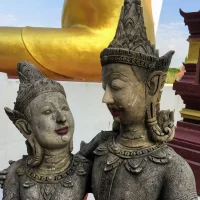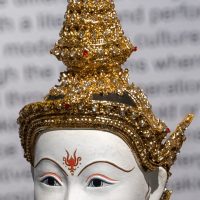Nang Sida : The Virtuous Queen
Listen
At a glance
| Description | |
|---|---|
| Origin | Thai Mythology |
| Classification | Mortals |
| Family Members | Thotsakan (Father), Mandodari (Mother), King Chanok, Queen Chantra (Adopted Parents), Phra Ram (Husband) |
| Region | Thailand |
| Associated With | Royalty, Virtue |
Nang Sida
Introduction
Nang Sida (นางสีดา) stands as one of the most revered heroines in Thai mythology and literature, embodying purity, loyalty, and the moral grace expected of an ideal woman. She is a central character in the Ramakien, Thailand’s national epic that was adapted from the ancient Indian Ramayana. In Thai tradition, Nang Sida is both divine and human—an incarnation of the goddess Phra Lakshmi, consort of Vishnu, and the faithful wife of Phra Ram (Rama). Her story of abduction by the demon king Thotsakan, followed by a long separation and eventual reunion with her husband, reflects timeless themes of devotion, virtue, and resilience. Through her trials, Nang Sida has become a cultural symbol of steadfast love and moral strength, deeply embedded in the Thai collective consciousness.
Physical Traits
Depictions of Nang Sida in Thai art and performance consistently highlight her serene beauty and royal dignity. In temple murals, especially those adorning the walls of Wat Phra Kaew (the Temple of the Emerald Buddha), she appears with a gentle countenance, almond-shaped eyes, and a calm, compassionate smile. She is always shown dressed in the exquisite finery of a Thai queen—golden silk garments, intricate jewelry, and the tall chada crown that symbolizes her noble status. In khon dance dramas, her movements are slow, deliberate, and graceful, embodying her elegance and restraint. Her physical beauty, however, is not merely ornamental—it is an outward reflection of her inner purity and virtue. This harmony of appearance and morality makes her an idealized image of womanhood in Thai cultural thought.
Family
In the Ramakien, Nang Sida’s family background differs slightly from that of her Indian counterpart, Sita. In Thai versions, she is sometimes described as being born from the earth itself, discovered as a miraculous child by King Chanok and Queen Chantra, who raise her as their daughter. Her divine origin reinforces her association with Phra Lakshmi, emphasizing her purity and sacred role. Nang Sida marries Phra Ram, the incarnation of Vishnu, establishing a divine union between the two celestial beings in human form. Together, they symbolize the harmony between righteousness and devotion. During her separation from Phra Ram after being abducted by Thotsakan, Nang Sida gives birth to twin sons, Phra Mongkut (Kusha) and Phra Loph (Lava), in some versions of the tale. Their birth signifies hope and continuity amid her suffering, underscoring the triumph of virtue over despair.
Other names
The name “Nang Sida” is unique to the Thai version of the epic, derived from the Sanskrit “Sita.” In neighboring Southeast Asian traditions influenced by the Ramayana, such as Cambodia’s Reamker and Laos’s Phra Lak Phra Lam, she is known as Neang Seda and Nang Sida respectively, maintaining her identity as the virtuous consort of the hero. In some Thai folktales, she is affectionately referred to as “Nang Sida Phom Hom,” meaning “Lady Sida with the Fragrant Hair,” a poetic reference to her spiritual and physical purity. These variations across regions highlight how her story has transcended linguistic and cultural boundaries while retaining her essence as a paragon of virtue.
Powers and Abilities
Unlike many mythological figures, Nang Sida’s strength lies not in physical prowess or magical abilities but in her unwavering moral power. Her greatest weapon is her virtue—an unshakable faith and devotion that withstands the temptations and torments of life. When Thotsakan abducts her and tries to persuade her to abandon Phra Ram, Nang Sida’s steadfast refusal becomes a spiritual act of resistance. Her inner purity is so powerful that it is often depicted as having divine protection; no harm can truly befall her because of her righteousness.
The most famous display of her spiritual strength is the trial by fire. To silence doubts about her chastity after being rescued, Nang Sida steps into flames to prove her innocence. Miraculously, she emerges unharmed, glowing with divine radiance, symbolizing her absolute purity. In Thai interpretations, this episode represents the triumph of truth and virtue over suspicion and worldly judgment. Her moral endurance also connects her to the Buddhist ideal of detachment and perseverance, linking her story not just to Hindu ethics but to Thai spiritual philosophy as well.
Modern Day Influence
Nang Sida’s legacy remains deeply woven into Thai art, culture, and education. Her story is brought to life in traditional khon dance dramas, where elaborately costumed performers retell episodes from the Ramakien with stylized gestures and classical music. These performances are not only artistic displays but also moral parables, reinforcing social virtues such as loyalty, patience, and faithfulness.
In visual arts, scenes depicting Nang Sida’s abduction, sorrow, and reunion appear in temple murals across Thailand, particularly in Bangkok and Ayutthaya. Her image has become a fixture of Thai iconography, representing both divine femininity and moral strength. In literature and poetry, her story continues to inspire reinterpretations—some modern writers explore her emotional depth and resilience, portraying her as more than a passive figure of virtue.
In recent years, Nang Sida has also become a symbol of female empowerment. Contemporary Thai artists and filmmakers have reimagined her character as a woman of emotional intelligence and inner strength, challenging patriarchal interpretations of her silence and suffering. Rather than being viewed solely as the loyal wife of Phra Ram, she is increasingly recognized as a moral force in her own right—one whose courage and integrity guide others through adversity.
Tourism in Thailand has also embraced her cultural significance. Performances and exhibits centered on the Ramakien at cultural sites like Wat Phra Kaew and the National Theatre continue to draw both locals and visitors. These presentations not only preserve ancient art forms but also reaffirm Nang Sida’s role as an enduring emblem of Thai heritage. Her influence extends to education as well, where her story is taught as a moral lesson emphasizing truth, perseverance, and virtue as timeless values.
Today, Nang Sida’s name evokes both nostalgia and reverence. She stands as a reminder that strength does not always come from might, but from steadfastness in the face of hardship. Through centuries of retelling, her story has evolved from a religious allegory into a universal narrative of human resilience and moral conviction.
Related Images
Source
Sita. (n.d.). In Wikipedia. Retrieved from https://en.wikipedia.org/wiki/Sita
Nang Sida. (n.d.). In Wisdom Library. Retrieved from https://www.wisdomlib.org/definition/nang-sida
The Ramakien. (n.d.). In Wikipedia. Retrieved from https://en.wikipedia.org/wiki/Ramakien
Nang Sida – The wife of Pra Ram. (n.d.). In Thai God/ Mythological Characters. Retrieved from https://mysticaldynasty.wordpress.com/history/thai-god/
Nanyang Academy of Fine Arts. (2019). Mask of Nang Sida. https://iseaa.nafa.edu.sg/resources/collections/artwork/mask-nang-sida
Tantipidoke, Y. (2013). Local healing in northern Thailand: An anthropological study of its effectiveness [Thesis, Universiteit van Amsterdam]. https://pure.uva.nl/ws/files/1977781/129278_thesis.pdf
TimsThailand. (2025, April 3). Nang Phom Hom, “The Fragrant-Haired Lady”. https://www.timsthailand.com/nang-phom-hom/
Mysakonnakhon. (2023, September 22). The Ramakien Thai Love Story – What it Really Means. https://mysakonnakhon.com/the-ramakien-thai-love-story-what-it-really-means/
Research Portal Erasmus University Rotterdam. (n.d.). Community participation in urban housing and infrastructure upgrading projects. https://pure.eur.nl/files/46430267/04-Dissertation.pdf
SEI Publications. (n.d.). Climate Risks, Regional Integration, and Sustainability in the Mekong Region. https://www.sei.org/mediamanager/documents/Publications/sumernet_book_climate_risks_regional_integration_sustainability_mekong_region.pdf
Frequently Asked Questions
What is lorem Ipsum?
I am text block. Click edit button to change this text. Lorem ipsum dolor sit amet, consectetur adipiscing elit. Ut elit tellus, luctus nec ullamcorper mattis, pulvinar dapibus leo.
What is lorem Ipsum?
I am text block. Click edit button to change this text. Lorem ipsum dolor sit amet, consectetur adipiscing elit. Ut elit tellus, luctus nec ullamcorper mattis, pulvinar dapibus leo.
What is lorem Ipsum?
I am text block. Click edit button to change this text. Lorem ipsum dolor sit amet, consectetur adipiscing elit. Ut elit tellus, luctus nec ullamcorper mattis, pulvinar dapibus leo.
What is lorem Ipsum?
I am text block. Click edit button to change this text. Lorem ipsum dolor sit amet, consectetur adipiscing elit. Ut elit tellus, luctus nec ullamcorper mattis, pulvinar dapibus leo.
What is lorem Ipsum?
I am text block. Click edit button to change this text. Lorem ipsum dolor sit amet, consectetur adipiscing elit. Ut elit tellus, luctus nec ullamcorper mattis, pulvinar dapibus leo.








